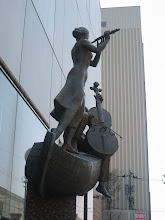I recently have become enamored with notebooks that can keep themselves closed. Islamic bindings have this feature. Islamic bindings have an extra bit of cover that wraps around over the front of the book. It protects the fore-edge of the book and, according to my extensive google research, the flap can also be used as a bookmark.
I experimented today with two lined notebooks about A6 in size. Each one has five signatures of four sheets each for a total of 80 pages. I used snaps attached to the flap and the front cover to keep the book closed. In my paper drawer was some paper that looked vaguely Islamic, so I used that as the cover paper.
Procedure:
1. Print out the pages which include lines, page numbers, my contact info, and, for no particular reason that I can discern, a picture of Claire Clairmont, Mary Shelley's husband's girlfriend. This took about one hour.
2. Fold and sew. Add the mull and extra strip of paper. This took about one hour, too. (Two books, remember.)
3. Measure and cut the book boards. This took about five minutes.
4. Measure and cut the book cloth. This was another well-spent five minutes
5. Glue everything together which took an additional 15 minutes or so.
6. Sew the snaps on. Gosh, golly. The first one took about fifteen minutes. The second one took about five minutes.
When I make another Islamic bound book I will use snaps again but I will make the books bigger, use thicker book boards, and apply the snaps before the book cloth.
What I learned on this excursion was to organize my material well. This enabled me to work quickly ~ or, at least more quickly than making just one book, for some reason.

























